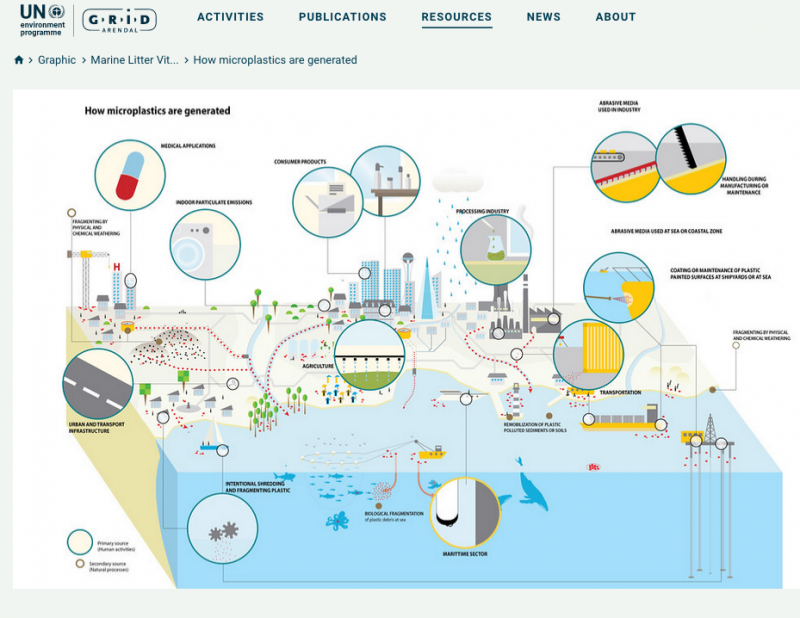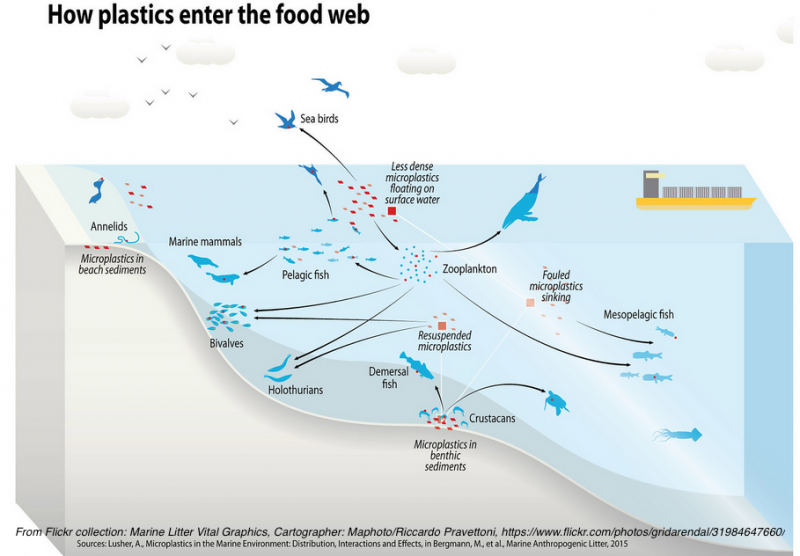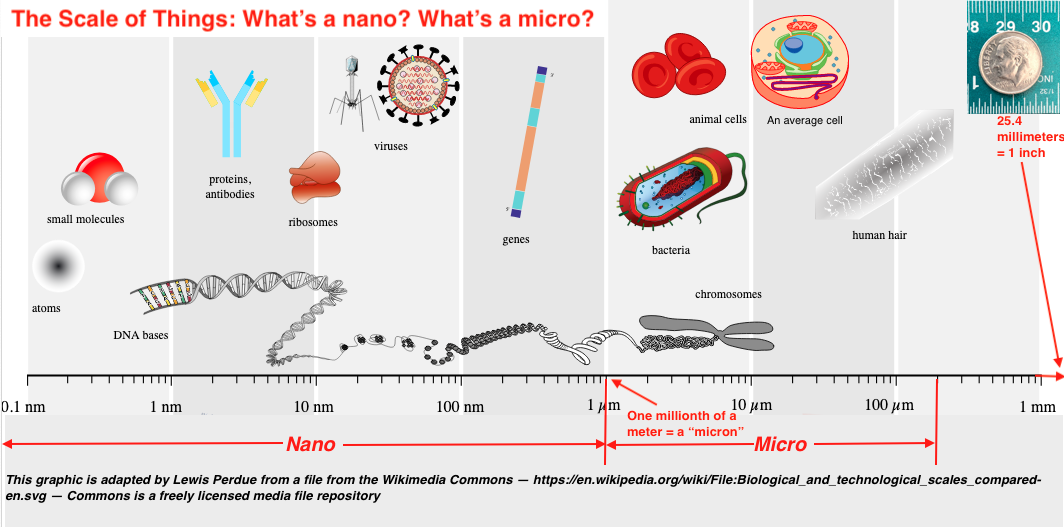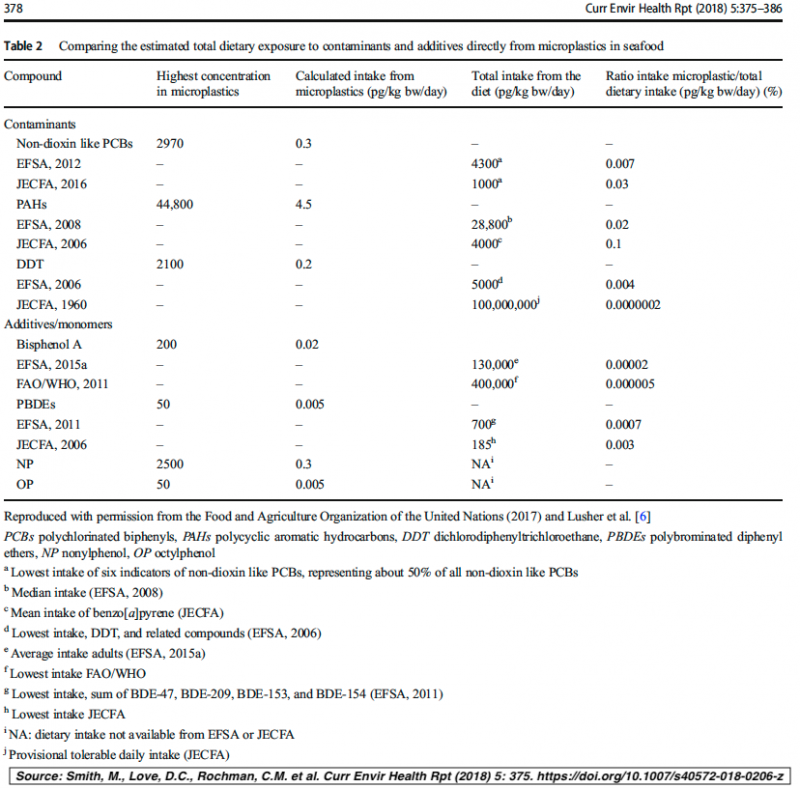Microplastics are generally those fragments that are less than five millimeters in size. However, a single microplastic fragment rarely stays the same size.
Whether found on dry land, in steams and oceans — or in your mouth as you chew, swallow and digest — natural and biological forces relentlessly reduce microplastics in size. Eventually, many microplastics become nanoplastics measured in millonths or billionths of a meter and capable of entering any cell in your body.
This ad-free article is made possible by the financial support of the
Center for Research on Environmental Chemicals in Humans: a 501(c)(3) non-profit.
Please consider making a tax-deductible donation for continued biomedical research.
Many microplastic particles can result from microscopic bits that slough off from plastic packaging, processing, transport and harvest.

Right-click image to access a much larger version. This illustration is one of a collection available at this UN-sponsored site: Marine Litter Vital Graphics
Regardless of size, microplastics present potential health from three possible factors:
- Physical size and accumulation in your body or other organisms,
- The leaching of harmful chemicals that are part of the plastic,
- Leaching of numerous hazardous chemicals which are adsorbed — accumulated on the surface — of microplastics. Even though the particular plastic may be harmless, many of the adsorbed chemicals are Persistent Organic Pollutants like Bisphenol A, DDT, dioxins that are deemed so hazardous that they have been banned by responsible nation states.
How seriously should we take microplastics as a health risk?
From: Anthropogenic contamination of tap water, beer, and sea salt:
“Plastics are hydrophobic and have been known to adsorb chemicals from the environment such as PCBs, PBDEs, and PAHs [21], some of which are known reproductive toxicants and carcinogens [22, 23, 24]. Plastic can also adsorb metals [25] and bacteria [26], sometimes at concentrations many times higher than their immediate surroundings [27]. Furthermore, there is evidence that once ingested some of these organic chemicals can desorb in the guts of animals [28]. Plastics can also leach synthetic additives, such as phthalates, alkylphenols, and bisphenol A [29]. A more recent study indicates that plastics can be cytotoxic to human cells [30]. Finally, plastic debris can serve as a unique microhabitat for marine organisms [31, 32] and aid in the transport of invasive species [33]. These known issues highlight why microplastics are considered a contaminant of emerging concern [34, 35, 36].”
There is no complete count of the chemicals container in, or leached from, microplastics. Some of the plastic-types frequently found in micro- and nanoplastics include: Polyvinylchloride (PVC: A notorious source of BPA), Teflon (PFOA, PFOS source), PolyStyrene, Polyethylene, high-density (PE-HD), Polyethylene, low-density (PE-LD), Polypropylene (PP), Polystyrene (PS), Polyamide (PA), Polyester (PES), Polyethylene terephthalate (PET). Those are the primary plastic composition, but most plastics are a mixture of polymers and contain additional additives.
Seafood and freshwater fish are particularly vulnerable
Marine organisms are particularly vulnerable to microplastic contamination because both terrestrial and airborne particles are washed into streams and the oceans by rain and wind. Farmed seafood may be more subject to contamination than wild caught due to feed contamination.

Click on graphic to view more images from this collection. This illustration is one of a collection available at this UN-sponsored site: Marine Litter Vital Graphics
Grocery store vegetables also at risk from micro- and nanoparticles
The use of municipal sewage treatment plant recycled wastewater (aka the “purple pipe” ) and the composted human fecal sludge left behind (biosolids) is growing more common.
This, despite documented health hazards from antibiotic resistant bacteria, pharmaceutical residues including opioids as well as illegal drugs like cocaine, heroin, and fentanyl. Recycled wastewater and biosolids also contain micro and nanosolids.
In addition, there is evidence that chemicals in recycled wastewater can be absorbed by root and leafy vegetables and that traces can remain after washing. The same holds for the use of biosolids which have been shown to contain antibiotic resistant bacteria, and promote their growth.
Significantly, Whole Foods is the only supermarket chain in the United States that has published an extensive list of standards and banned substances. In addition, in 2014, the chain banned the sale of biosolid-grown foods. and has maintained that restriction.
The company is less forthcoming about the use of recycled wastewater. However, many substances in recycled wastewater are covered in Whole Foods’ list of unacceptable ingredients in food
It is important to uhderstand that state and fedewal regulations regulations are unclear regarding the use of recycled wastewater in certified organic foods.
Best Practices: Replicability requires the ready ability of other investigators to acquire reagents (food in this case) from the same or equivalent source. Whole Foods is the only national supermarket chain in the United States that has banned biosolids, and has published significant transparency details regarding its foods. Until other national chains or their suppliers provide comparable data, Whole Foods would be the most accerptable source. However, it is vital to recognize that their standards have not included the elimination or reduction of plastic-derived chemicals. For that reason, additional care must be taken with specific products to minimize contamination from Bisphenol A and other plasti c contaminants.
Nanoplastics: potent and largely unstudied
The smaller the particle, the more potent it becomes and the harder to detect.
Nanoplastics, for example, are the most likely to invade cells because they are small enough to pass directly through the outer membrane. Evolution has not yet equipped cells with any method of rejecting nanoplastics or other nanoparticles.
Medical science is well aware of the ability of nanoparticles to travel through the blood-brain barrier. Indeed, nanoparticles are being evaluated as ways to deliver drugs that are otherwise unable to transcend the blood-brain barrier.
Astonishingly, scant research — none on humans — has been published to assess the effects of environmental nanoplastics on the brain, behavior, or serious diseases. The current state of the science seems to rest with a handful of studies that have found that have found physical and behavioral harms to fish.
The published literature seems devoid of publications that determine the effects of delivering Bisphenol A, phthalates or any other environmental chemicals directly to the interior of a human nerve cell — or any other cell.
No efficient, effective way to screen for nanoplastics
Because of the very small size of nanoparticles, standard screening techniques cannot be used. There are a number of developing methods, but they are plagued y inaccuracy and expense.
“Because no routine detection method exists for nanoplastic, and no data on environmental concentrations are available, we can only make plausible hypotheses on the environmental fate of such particles — hypotheses that now need verification, because the possibly high number concentrations combined with the bioaccumulation and toxicity profile and the ability of plastic to sorb hazardous organic chemicals have led to serious concerns about environmental risks.”– Albert A. Koelmans, Nature, Nanotechnology
“To this day (2017) it is not known how to detect nanoplastics in real environmental samples” — Gerrit Renner, et al – Current Opinion in Environmental Science & Health
Resources
Microplastics in general
Review of micro- and nanoplastic contamination in the food chain
An example of how microplastics could end up on a consumer’s plate
Human Consumption of Microplastics
Microplastics in Seafood and the Implications for Human Health
New Link in the Food Chain? Marine Plastic Pollution and Seafood Safety
White and wonderful? Microplastics prevail in snow from the Alps to the Arctic
Microplastic pollution in commercial salt for human consumption: A review
Microplastics in Spanish Table Salt
Marine microplastic debris: An emerging issue for food security, food safety and human health
Human Consumption of Microplastics
Global Pattern of Microplastics (MPs) in Commercial Food-Grade Salts: Sea Salt as an Indicator of Seawater MP Pollution
Anthropogenic contamination of tap water, beer, and sea salt
The presence of microplastics in commercial salts from different countries
Pollution in the Marine Environment: Plastics, Microplastics and Organic Pollutants
Microplastic contamination of table salts from Taiwan, including a global review
New Link in the Food Chain? Marine Plastic Pollution and Seafood Safety
Anthropogenic contamination of tap water, beer, and sea salt
Wind erosion as a driver for transport of light density microplasticsNanoparticles
Analytical methodologies for monitoring micro(nano)plastics: Which are fit for purpose?
Applications of nanoparticle systems in drug delivery technology
Nanoparticle-mediated brain drug delivery: Overcoming blood–brain barrier to treat neurodegenerative diseases
Role of nanoparticle size, shape and surface chemistry in oral drug delivery
Role of Nanoparticle Mechanical Properties in Cancer Drug DeliveryMicro(nano)plastics – Analytical challenges towards risk evaluation
Emergence of Nanoplastic in the Environment and Possible Impact on Human Health
Separation and Analysis of Microplastics and Nanoplastics in Complex Environmental Samples
Detection of nanoplastics in food by asymmetric flow field-flow fractionation coupled to multi-angle light scattering: possibilities, challenges and analytical limitationsBiosolids, recycled wastewater
Evidence of microplastic accumulation in agricultural soils from sewage sludge disposal
Are Agricultural Soils Dumps for Microplastics of Urban Origin?
Microplastic Incorporation into Soil in Agroecosystems
Is giving treated wastewater to livestock legal?
Microplastics as an emerging threat to terrestrial ecosystems



Comments are closed.